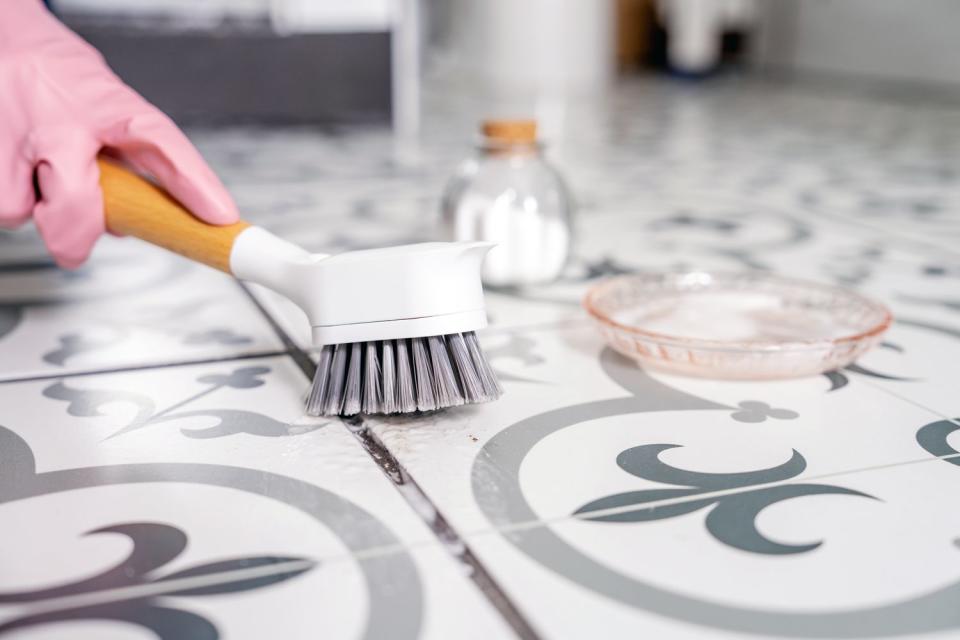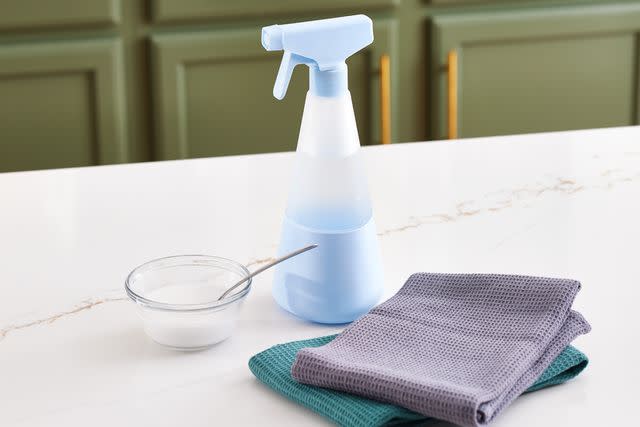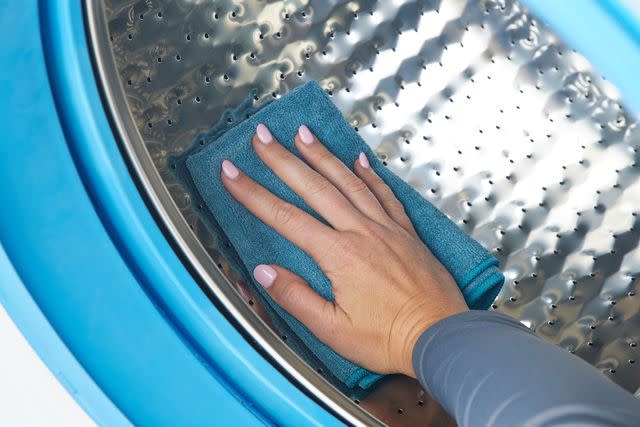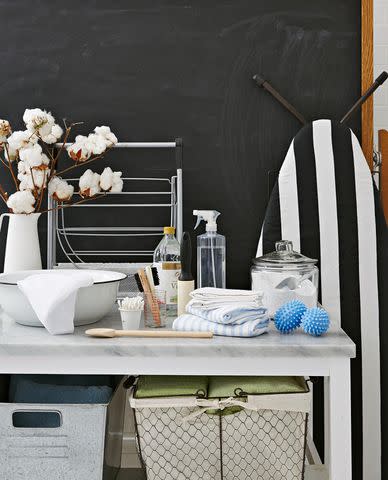21 Things You Can Clean with Hydrogen Peroxide
It’s time to retire the brown bottle from your first-aid kit and put it to work sanitizing your home.

BHG / Danielle Moore
Doctors and parents alike have been using hydrogen peroxide to disinfect scrapes and keep wounds clean for the better part of the past century. But in the past few years, medical professionals including the CDC have discouraged the use of the chemical on skin. Before you toss the signature brown bottle from your medicine cabinet or under the bathroom sink, consider using it around the house instead.
Since it is an antiseptic, hydrogen peroxide can be used to go after the germs and bacteria lurking on the surfaces you touch daily. And like rubbing alcohol, there’s a laundry list of things you can use this economical household staple to scrub clean—including the laundry itself! These are all the things you can clean with hydrogen peroxide around your home.
Related: Homemade Cleaners You Can Make with Ingredients from Your Pantry
Hydrogen Peroxide Safety Tips
There are a few things you should know before handling hydrogen peroxide. It’s a chemical compound that’s comprised of two hydrogen atoms and two oxygen atoms. You can find hydrogen peroxide in almost any grocery or drugstore, and 3% is the most commonly found concentration. Even though it might seem like a small amount, hydrogen peroxide is a very powerful cleaning agent—so even just 3% can cause adverse side effects if ingested or comes in contact with sensitive areas. If you happen to accidentally spash some your eye while cleaning, flush it out immediately with water.
As with most cleaning supplies, make sure you’re in a well-ventilated space when you’re working with hydrogen peroxide. Consider wearing gloves to protect your skin and, regardless of the surface or material, we recommend testing out how the peroxide will react with any space in a small spot first. Lastly, it’s imperative not to mix hydrogen peroxide with bleach, ammonia, or vinegar, as the combinations can cause toxic fumes and, in the case of rubbing alcohol, a potential fire hazard.
Related: How to Safely Store Cleaning Supplies
Things You Can Clean with Hydrogen Peroxide
In general, hydrogen peroxide serves as an inexpensive, yet effective, multi-purpose disinfectant. Simply mix one part hydrogen peroxide with one part water, spray it onto germy surfaces, wait five minutes, and then wipe clean. Here are several things you can clean with the solution around your home.

Brie Goldman
1. Countertops and Cooktops
Make a DIY kitchen cleaner the same way you would make a multi-purpose disinfectant and use it every night after dinner. Struggling to remove stuck-on grease? Combine hydrogen peroxide with baking soda (a safe combination), allow the paste to sit on the mess overnight, and use a non-abrasive sponge to rinse away in the morning.
Related: How to Clean Kitchen Countertops—Our Best Tricks for Any Material
2. Showers and Bathtubs
Warding off mold and mildew in the shower can feel like an endless chore. Thankfully, hydrogen peroxide makes it a little easier by killing the fungus for you. Spritz some all around the shower and tub—including the liner—and rinse. If there are stains left behind, you can add baking soda to the peroxide to form a paste with some scrubbing power. Hydrogen peroxide alone can brighten dingy white grout but, again, feel free to incorporate baking soda to remove built-up grime. Stubborn soap scum won’t stand a chance if apply a mixture of peroxide, baking soda, and vinegar. Leave it on affected areas to foam, then wipe and rinse for a shower that sparkles.
Related: How to Clean a Shower So It Sparkles from Top to Bottom
3. Cookware and Dishes
The same hydrogen peroxide and baking soda concoction can also work to remove baked-on food that’s hard to scrub off pots, pans, and baking sheets. The power duo can also make well-loved cookware shine like new again. If you’re handwashing dishes, add a few drops of peroxide with your dishwashing soap to help take on some of the elbow grease. You can use this combination on detachable grill grates as well.
Related: The 7 Best Degreasers of 2024 for Extra Cleaning Power
4. Mirrors and Glass
Want a cost-effective and natural way to clean the windows, mirrors, and glass surfaces around the house? Simply spray them with hydrogen peroxide and wipe them down with a lint-free cloth (or crinkled-up newspaper if you have any lying around). You’ll be left with a streak-free shine without exposure to chemicals.
Related: These Natural Cleaning Products Keep Chemicals Out of Your House
5. The Dishwasher
No matter how often you run it, dishwashers emit a funky smell from time to time. Sure, you can clean your dishwasher with vinegar or bleach, but if you’re running low on both, hydrogen peroxide can sub in. Place a quarter cup of peroxide on the top rack of the dishwasher while it’s empty and run a high heat cycle to eliminate whatever’s causing the odor, be it bacteria or mildew. You can also spray some peroxide in the rubber seal and hard-to-reach areas after the load is done so you cover all your bases.
Related: The 10 Best Dishwasher Cleaners of 2024 to Keep Your Appliance in Top Shape
6. Carpets, Rugs, and Upholstery
Hydrogen peroxide can work to eliminate stains on fabric found throughout the house. Begin by testing a discreet spot on the carpet, rug, or upholstered furniture, and then proceed to use the same method as you would for treating clothes. For an added boost of stain removal strength on carpets, you can combine peroxide with dish soap or steam.
7. The Kitchen Sink
Hydrogen peroxide works wonders on white surfaces. So if you have a white kitchen sink, you’re in luck. Sprinkle baking soda generously all over the inside basin before pouring a small amount of peroxide over it. Get to scrubbing and, when satisfied with how clean your sink is, rinse the mixture down the drain and wipe the area dry.
Related: How to Clean a Drain and a Kitchen Sink
8. Beauty, First Aid, and Hygiene Tools
Keep bacteria from spreading by regularly cleaning makeup brushes, tweezers, thermometers, manicure tools, loofahs, and more by soaking them in or wiping them down with hydrogen peroxide. You can also effortlessly disinfect your toothbrush and retainer (without spending a small fortune on a UV sanitizer) by soaking them for a few minutes in peroxide and rinsing well before using them again.
Related: 8 Things in Your Makeup Drawer You Should Clean or Toss Right Now
9. Sponges
Whether it’s in bleach, vinegar, the microwave, or the dishwasher, there are several ways you can clean a kitchen sponge. And if you have hydrogen peroxide on hand, you can also add it to the list. Soak sponges weekly in a bowl of 50% peroxide and 50% water for about ten to twenty minutes to kill off lingering bacteria. Rinse the sponge and let it air dry before using it again.
10. The Refrigerator
The next time you’re decluttering and reorganizing the fridge, take the opportunity to sanitize the inside while it’s empty. Apply hydrogen peroxide to a cloth or sponge and wipe down the shelves, drawers, side walls, and the door seal.
Related: How to Make a Fridge Smell Better and Get Rid of Stale and Foul Odors
11. Houseplants
If your beloved houseplants have become infected by fungus (like root rot) or pests, spray the affected areas with a mixture of one part hydrogen peroxide and three to four parts water. You can also clean your pruning tools with peroxide to sanitize them and prevent the spread of disease from plant to plant.
Related: How to Clean Your Houseplants to Get Rid of Dust and Pests

Jacob Fox
12. The Washing Machine
Like dishwashers and showers, washers can develop mold and mildew, especially if you tend to shut the lid too quickly after a load. If it smells musty, pour two cups of hydrogen peroxide into the drum and run a hot cycle to eliminate odor and any possible growth. After, wipe peroxide around the inside of the rubber gasket seal to clean any lingering residue.
Related: How to Clean a Washing Machine for Fresh Clothes and Linens
13. Garbage Cans
On the next trash day, after you’ve taken the garbage out, spray the inside of your trash cans with a mixture of hydrogen peroxide and water. Allow them to air dry—outside in the sun if possible—so they're clean, odor-free, and ready for a fresh bag.
Related: The 12 Best Kitchen Trash Cans
14. Flooring and Tile
Remove dirt and grime from various types of flooring, such as hardwood, tile, vinyl, laminate, and concrete, with the help of hydrogen peroxide. Dilute peroxide with water and either mop or spray the solution directly onto the floor. Immediately wipe clean and dry it to avoid potential water damage.
Related: How to Clean Floors Using a Steam Mop
15. Toilet Bowls
Commercial cleaner or bleach can be used to clean the toilet bowl, but hydrogen peroxide works just as well on stains and germs. Pour half of a cup of peroxide directly into the bowl, let it sit for up to 30 minutes, and then scrub stains away before flushing. It not only leaves the bowl sparkling, it also works to sanitize it. You can also soak the toilet brush in hydrogen peroxide for the same effect.

16. Clothing Stains
In lieu of a laundry stain remover, hydrogen peroxide can act as a potent pre-treatment for almost any kind of clothing stains, including wine, food, grass, and even blood stains. First, test an inconspicuous spot to make sure the peroxide doesn’t discolor the garment and, once you know it’s safe to use, pour a small amount of it directly on the stain. Let the fizzy action work for a minute before dabbing the area, repeating as necessary until the stain is gone. Either rinse with cold water or wash the garment as usual.
You can also boost dingy whites without bleach by adding one cup of hydrogen peroxide to the washing machine before running it. As a bonus, it will sanitize what’s in the load so they’ll look and smell fresher than before.
Related: 13 Essential Laundry Tips for Keeping White Clothes White
17. Bedding and Mattresses
Not only can you use the same method for cleaning sheets and blankets as you can for clothing, hydrogen peroxide has another beneficial effect when it comes to your bed. If you suffer from dust mite allergies, mix one part peroxide with one part water in a spray bottle and spritz your mattress to kill the pesky, microscopic critters that love to take up residence there. Wait until it’s fully dry before making up the bed with clean sheets.
Related: Vacuuming Your Mattress Is the Crucial Bedroom Cleaning Step You Shouldn't Skip
18. Cutting Boards
If you’re worried about contamination while cooking, there are a few methods for cleaning cutting boards that you can use to sanitize the boards. The beauty of hydrogen peroxide is that you can spray plastic, wood, or even marble versions with it to ward off bacteria like Salmonella and E. coli. Let the peroxide sit on the boards for up to ten minutes before rinsing clean.
19. Kids' Toys
Whether they’re stored in bedrooms, the playroom, or the garage, kids’ toys are bound to get riddled with dirt and germs. Hydrogen peroxide provides a non-toxic way to get them clean and sanitized at the same time. As long as they’re not battery operated or have any electronic components, soak toys in a tub of equal parts peroxide and water. Let them sit for a few minutes and then rinse with clean water. If they require batteries or need to be charged, dip a cloth in the solution and carefully wipe the toy, avoiding any sensitive parts.
Related: 25 Toy Storage Ideas to Help You Tidy Up
20. Fresh Produce
You’ve probably heard of the baking soda method for washing fruits and vegetables. But did you know that hydrogen peroxide can be used as a substitute? Not only can soaking produce in a 1:4 ratio of hydrogen peroxide and water for up to 30 minutes (or less for more delicate items like leafy greens) remove harmful substances like dirt and pesticides, it may also help to extend their freshness.
21. Humidifiers and Dehumidifiers
If you regularly use humidifiers or dehumidifiers, you can easily improve the air quality in your home by using this one trick monthly. Combine equal parts hydrogen peroxide and water and run it through the machines to remove any possible mold and mildew.
Related: How to Clean an Air Purifier
For more Better Homes & Gardens news, make sure to sign up for our newsletter!
Read the original article on Better Homes & Gardens.

